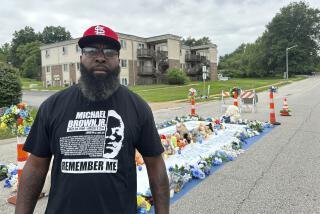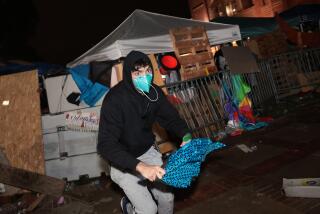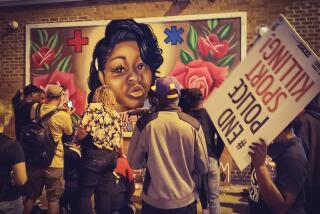Trapped in Ferguson protest zone: 3 students describe tense night
- Share via
Reporting from Ferguson, Mo. — Three college student from Ferguson found themselves trapped overnight behind the riot-ready police lines of this embattled St. Louis suburb roiling over the fatal police shooting of Michael Brown.
The women had come to protest but were unprepared for the sporadic clashes that unfolded after dark between police and demonstrators.
Alexis Tucker had talked her two high school classmates into coming: Alexis Mays, a cautious biology major with a stylish handbag, and Elvony Pleasant, a psychology major with a quick wit.
Tucker, 19, a sophomore communications major at Howard University, had been protesting all week, despite her parents’ concern about her safety. Like her friends, she arrived on West Florissant Avenue dressed for a night out, her hair tied in a leopard-print scarf, wearing strappy sandals and carrying a matching purse.
They had parked in an area surrounded by a high metal fence behind a credit union, a spot that police had designated for protesters. They thought it was safe. But once the protest swelled after 10 p.m., police began massing, blocking the credit union entrance with their human chain: dozens of officers clad in gas masks and riot gear.
The trio took shelter in the parking lot of a neighboring Family Dollar store and watched the standoff unfold, humming spirituals like “Wade in the Water” they had sung while marching earlier in the day, songs their grandparents had sung during civil rights protests.
They had reveled in the gathering that afternoon, chanting “Hands up, don’t shoot,” walking the street with a crowd that included plenty of other women and youths.
“Justice is necessary to fight for,” Tucker said.
But they grew worried.
“It was peaceful protests, but now it’s past that,” said Pleasant, 18, a sophomore at the University of Missouri-Columbia, as she watched police with long guns zoom by in a military-style truck.
“Do you see how many people they just added to that line?” said her college classmate Mays, 19.
Someone threw a glass bottle. It shattered on the pavement in the breach, and police rushed forward.
The young women cringed, drawing back toward the brick storefront. The lot was fenced. They had nowhere to run.
“Do not throw an object!” police instructed over a bullhorn, moving in a caterpillar line toward the offender.
“They are actually moving like soldiers, like that movie ‘300,’” Pleasant said in awe.
She quickly grew frustrated.
“We’re not trying to fight them,” she said of police. “We don’t have any of the gear they have on.”
As they watched, police arrested a woman.
“Why did she just get arrested?” Mays wondered aloud.
Tucker scrutinized the blue line of police.
“It’s a scary situation for both sides,” she said.
The standoff cooled, then heated up momentarily when two boys rode their bike up to the police line. Officers barked, shifting forward as a mass.
“Kids!” Tucker yelled.
The boys retreated, and so did the police. The trio of students were disgusted. They had fond memories of seeing police officers visit their schools for anti-drug campaigns and other public service programs.
“How are the kids coming up now going to be looking at them? Like ‘I don’t trust you!,’” Tucker said.
They wished that the officers would take off their gas masks, drop their riot shields and nightsticks and talk to the people.
“It’s all about power,” Mays said, “I feel like they’re holding us hostage. I don’t know how they want us to leave.”
Two police helicopters circled, lights illuminating the line of uniformed officers and the protesters. About 11 p.m., a military vehicle zoomed into the dwindling crowd. An officer on top pointed a long gun.
“Why did he drive over there with a rifle pointed?” Mays asked.
“To provoke us,” Pleasant said.
Tucker pointed.
“They’ve got their sticks drawn,” she said.
Mays started to panic as she watched officers pulling on gas masks again.
“What are they doing? What are they getting those on for?” the biology major said.
Confusion erupted. Loud booms sounded down the street.
“They’re shooting!” Tucker shouted.
Police at the other end of the street had fired tear gas canisters. There had been a shooting, with two people injured.
The women sprinted to the darkest corner of the parking lot, briefly retreating. Then they moved back up to the street to see what had happened.
They watched as protesters refused to leave.
“Back up now!” an officer shouted over a bullhorn.
“This is our home!” a female protester shouted back.
Tear gas drifted closer. Tucker unwound her hair wrap. The women draped it over their faces. Mays donned sunglasses. They clutched tissues to their mouths. But their noses still burned, and started running.
“It smells like fireworks,” Pleasant said.
About 11:30 p.m. they wanted to leave, but would have had to cross through the police line. They decided to ask a black police officer for an escort, figuring he would be sympathetic. They approached him slowly, arms raised.
But he was short with them, saying they needed to ask officials down the street — where the tear gas was deployed.
“Will we get arrested or be able to get our car?” Pleasant asked.
He couldn’t say.
They walked to the edge of the street.
“People just want to go home,” Pleasant said. “I just want to go home.”
Tucker was hungry. Mays had to go to work the next day, and it was her car that was stuck.
It was 11:42 p.m. Police took to the bullhorn again. Everyone in the area aside from journalists had to leave.
“You will be subject to arrest!” the officer warned protesters who had not left the area. “Do it now!” the officer shouted.
The girls decided to cross the street and ask for help again.
A police officer yelled at them as they ran through the chaotic crowd.
“Let’s go!”
Tucker, exhausted and scared, struggled to remain composed.
“We are human beings,” she said.
A white police officer approached and asked what they needed. After the trio explained, he said he would try to help. He lead them back to the road, then escorted them to their car.
They drove directly to Steak ‘n Shake, where they pondered the menu and the night’s events.
They would have a story to tell their grandchildren, just as their grandparents had told them about civil rights protests of the 1960s. But what would their story be?
“You can’t stereotype police,” Mays said, “When we went to the black officer, he was actually meaner than the one who helped us, who was white.”
But Pleasant had learned a different lesson. They would not have needed to be rescued if they had not been trapped in the first place by police, she said. She thought the overwhelming show of force was unwarranted.
“If they have the power, they will use it,” she concluded, “any way they can.”
For more news from Ferguson, follow @mollyhf on Twitter.
More to Read
Sign up for Essential California
The most important California stories and recommendations in your inbox every morning.
You may occasionally receive promotional content from the Los Angeles Times.











